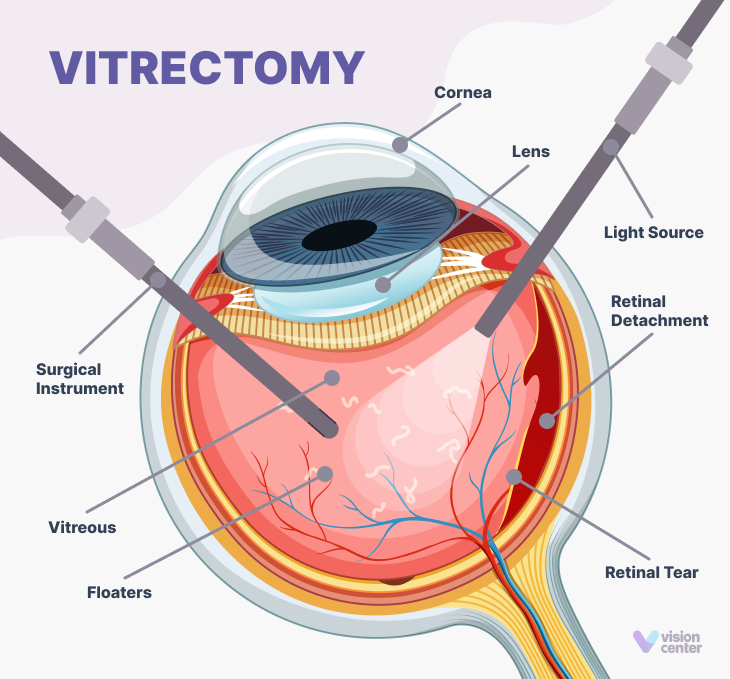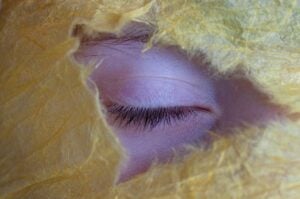A macular pucker, epiretinal membrane (ERM), or wrinkled retina is scar tissue that forms on the macula. The macula is located at the retina’s center, the eye part responsible for detailed vision.
A macular pucker usually occurs in one eye, but both can be affected, with most patients experiencing mild visual distortion. In severe cases, especially if the macular pucker interferes with your quality of life, surgery is the most effective treatment.
In this article, we’ll look at macular pucker surgery in detail, including:
- The best candidate for the surgery
- Potential risks and benefits of the surgery
- Step-by-step macular pucker surgery procedure
- Post-surgery recovery process
What is Macular Pucker Surgery?
Macular pucker surgery (vitrectomy) is an outpatient procedure performed on the eye’s retina to remove the abnormal membrane causing a wrinkle or pucker.1 The surgeon removes the vitreous gel from the eye cavity and peels the abnormal membrane from the retina’s surface using precision surgical instruments. Vitrectomy is performed under local or general anesthesia.

Other surgical procedures developed for macular pucker include:
- Membranectomy.2 Removal of the abnormal membrane from your retina. It does not involve vitreous gel removal.
- Fluidic Internal Limiting Membrane Separation (FILMS).3 This is a new procedure still under development. After vitrectomy, a fluid is injected between the membrane and the retina, causing the scar tissue to lift away. The tissue is then removed using a pair of forceps.
Surgery will significantly improve your distorted central vision. However, the exact outcome is hard to predict. Not undergoing the recommended surgical intervention increases your risk of complications such as severe vision loss or macular holes. However, complete blindness is impossible since macular puckers only affect central vision and not peripheral vision.
Who Needs Macular Pucker Surgery?
Most people with macular puckers only experience mild symptoms that may require glasses, reading lamps, or magnifiers.4 Some people may get used to the vision changes.
If a macular pucker affects the quality of life by hindering important activities such as reading and driving, your eye doctor may recommend surgery.
The following symptoms may necessitate surgery:
- Severe wavy/distorted vision (metamorphopsia)
- Significant vision loss (20/50 or worse)
- Vitreous hemorrhage
- Double vision (diplopia)
- Changes in object size (macropsia)
- Severe eye injury from a dislodged or infected intraocular lens (IOL)
Potential Risks and Benefits of Macular Pucker Surgery
Despite the vision benefits of vitrectomy, there are potential complications and side effects. These include the following:
- Inflammation or redness, swelling, and eye pain
- Loss of night vision
- Retinal tear or retinal detachment during the procedure or after
- Increased rate of cataract development (clouding of the eye lens)
- Eye infections due to bacterial, viral, or fungal contact
- Excessive bleeding from the site of surgery
- Macular hole
- Glaucoma (high eye pressure)
- Lens damage
- Change in refractive error
- Allergic reactions to anesthesia
Fortunately, these issues are largely preventable. For example, cataract development can be resolved through surgery (replacement of the natural eye lens with an intraocular lens).5 Depending on the causative agent, eye infections can be prevented or managed using antibiotics, antifungals, or antivirals.
Sometimes, the initial surgery may not solve the problem, necessitating a repeat procedure.
Is Macular Pucker Surgery Worth It?
Macular pucker surgery is worth it if the wrinkles affect your vision and prescription glasses aren’t effective. Surgery will significantly improve your retina’s ability to focus light. However, the exact outcome is hard to predict.
Ignoring recommended surgery increases your risk of complications such as severe vision loss or macular holes. However, total blindness is impossible since macular puckers only affect central vision, not peripheral vision (side vision).
However, before agreeing to the procedure, inquire from your doctor about the following:
- Alternative remedies, such as prescription glasses
- Expected results of the surgery
- Possible side effects
- The recovery timeline
- The cost of the procedure
Macular Pucker Surgery Procedure
Below is what you can expect before, during, and after macular pucker surgery:
Before surgery
After scheduling your surgery day, ask your doctor about any preparations you need to make. They may advise you to stop taking medications, especially those that can interfere with healing (e.g., anticoagulants or blood thinners). You may also need to avoid eating anything after midnight before your surgery.
Your eye doctor may also perform several eye exams before surgery to examine the integrity of your retina and visual acuity.
During surgery
On surgery day, your surgeon will prepare your eyes by administering local or general anesthesia. They will use an eye speculum to hold your eyelids open and do the following:
- Make an incision. Using a special blade, the surgeon will make an incision on the sclera (the white part of the eye) to expose the vitreous gel.
- Vitreous gel removal. The surgeon will remove part of the vitreous gel to create room for removing the scar tissue and doing other repairs.
- Peeling of the scar tissue. Special microsurgical instruments such as forceps, scissors, and cutters will gently peel the scar tissue from the retinal surface.
- Removal of foreign objects. The surgeon will check for foreign material before repositioning the retina at the back of the eye.
- Structural repair. In cases of retinal tear, laser treatment may be used to repair the area.
- Filling with gas or silicone oil bubble. This is done to replace the vitreous gel and helps keep the retina in position (the bubble usually goes away on its own).7
- Stitching. Your surgical incisions may be closed with stitches, although not always necessary.
- Antibiotic application. The surgeon will apply an antibiotic ointment to prevent eye infections.
The duration of the procedure will depend on the severity of your condition. On average, the surgery may last about one hour or more.
After Surgery
An eye patch or shield will also be applied for protection following surgery. The patch should stay in place until the following day or per your surgeon’s advice.
The surgeon will also monitor your eyes for a few hours as you recover from the anesthesia. They’ll prescribe medication to help relieve any immediate pain and discomfort and provide you with post-op care instructions.
Ensure you’ve arranged transportation back home after the procedure. The effects of sedation may linger after surgery, thus impairing your ability to operate machinery effectively.
Most vitrectomy cases require a postoperative examination within 24 hours of surgery to confirm the procedure’s success.8 The follow-up will also allow you to learn about your post-op care responsibilities and get any concerns addressed. You must attend regular follow-up sessions during the first six weeks to monitor your recovery.
Recovery Process for Macular Pucker Surgery
The recovery process for macular pucker surgery is gradual, with most people regaining at least half their vision. For a few days, your eyes may experience pain and discomfort, and your vision may be blurry.
The symptoms should go away with time as long as you strictly follow your post-op care instructions. If stitches were applied, it may take about 4 to 6 weeks to dissolve. During this time, your eyes may feel gritty and appear inflamed.
Recovery Timeline for Macular Pucker Surgery
You will need at least 2 to 4 weeks post-op before starting normal activities like work, driving, and reading. However, this timeline may vary depending on several factors:
- Age
- Visual acuity status of your other eye (if only one is affected)
- Activity level before surgery
Complete recovery may take about 3 to 6 months or more on average. After full recovery, you can be prescribed new glasses depending on your refractive error.
Restrictions During Macular Pucker Surgery Recovery
You’ll also be required to moderate certain activities to ensure a successful healing process. These include:
- Driving (resume driving 48 hours after the surgery if vision is clear)
- Eating and drinking (you can resume after 24 hours, but avoid alcohol)
- Reading/watching TV (wait about 24 hours)
- Intense exercise (until full recovery)
- Showering, swimming, or direct water exposure (After about 24 hours)
- Routine household chores (scrubbing or lifting heavy objects)
- Air travel
- Applying make-up
- Rubbing your eyes
- Mountain climbing or scuba diving
- Sexual activity (for about one week)
- Playing with pets or small children (risk of accidental poke)
If you experience severe pain, worsening vision, or any concerning side effects, consult your doctor for better management.
How Do You Sleep After Macular Pucker Surgery?
The American Academy of Ophthalmology (AAO) recommends sleeping face down (or sideways), with the operated eye hanging off the edge of the bed.9 This prevents pressure build-up in the eye, which can lead to other complications.
To adhere to the face-down rule of sleeping, you can invest in face-down pillows, which have a space cut out for your face to improve comfort during sleep.
Other equipment you can use to maintain the face-down posture include:
- Face-down chairs. To provide support for your head and neck when seated.
- Tabletop face cradles (headrest). To hold your face and help keep your hands free while sitting at the table.
Can Macular Pucker Return After Surgery?
Research shows that macular pucker can grow back after removal.6 However, this is rare, and the need for reoperation is minimal.
Speak to your eye doctor if you notice recurring symptoms like blurriness or double vision. We recommend regular eye exams to detect any abnormalities after surgery.
Summary
- Macular pucker surgery (vitrectomy) is a surgical procedure performed on the eye’s retina to remove the abnormal retinal tissue causing a wrinkle or pucker.
- The surgery is usually recommended if the macular pucker affects your quality of life by hindering important activities such as reading and driving.
- Macular pucker surgery is performed under general local anesthesia to help with pain and discomfort.
- After surgery, your surgeon will provide post-op instructions and antibiotic eye drops to help with a successful visual recovery.
- Macular pucker surgery has a success rate of 70-90%, with most patients regaining significant visual acuity.
- It’s important to follow your surgeon’s advice and consult them for personalized care.
In this article







